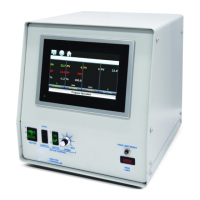4848T Reactor Controller with Touchscreen
17
COMMUNICATIONS
This section provides instructions on how to
use the 4848T communication interfaces. As a
standard, the 4848T is equipped with an Ethernet
interface for user communications.
Ethernet Communications
The 4848T provides two forms of Ethernet com-
munication interfaces for monitoring and control-
ling the system across a network. The web server
interface provides a monitor only connection, while
the VNC server interface allows a user to manipu-
late and control the 4848T remotely by viewing the
4848T display directly on their PC screen.
NOTE: In order to use Ethernet communications, the
4848T must be properly connected to a network. To
connect the 4848T to a network, connect the touch-
screen’s Ethernet port to your network using a standard
CAT5 cable connection. Note that after connecting the
network cable, it may be necessary to cycle power to
the 4848T in order for it to obtain a valid IP address.
Guide to Smart Networking Practices
The expansion of Ethernet onto the industrial floor
has brought forth a new realm of possibilities from
the gathering of information to the inherent control
of equipment from anywhere around the world. The
flexibility and convenience that this provides makes
it a very desirable feature for new equipment. The
4848T provides this ability, but there are consider-
ations that must be taken by the end user to protect
their equipment and investment.
Just like placing a personal computer on the internet
opens it up to outside attack, placing your 4848T on a
network poses the same risk. The first thing to re-
member is this: The most likely cause of problems is
not a hacker trying to sabotage your equipment, but
more often to be related to the ubiquity of PCs with
Ethernet cards, the ease with which your own co-
workers can “hang stuff on the network”, and careless
or nonexistent internal security measures. Accidental
problems are more common than deliberate ones.
Allowing anyone access to the 4848T by placing it
on the office LAN, also opens the door for accidental
shutdown, damage to equipment, loss of data, lost
time, etc. This is possible even by the most well-
intentioned co-workers. Thus, there are several steps
that should be taken to minimize this risk.
The first is to never mix your office LAN with your
control LAN. The control LAN should be a separate
network that consists of your 4848T controller(s) and
possibly any other equipment that you may have that
is related to the operation of the system. It should be
separated from your office LAN by a firewall, or at
minimum, a bridge or router. A control network and a
business network have two entirely different purpos-
es and their interaction should be closely controlled.
It is also unwise to assume that any Ethernet capable
devices themselves have any security features at all.
The 4848T VNC server only provides minimal single-
password based security access. Separating the con-
trol LAN from the office LAN using a firewall would
increase security and only allow control access that
is based on a combination of IP source address,
destination address, and port number. This is by no
means completely “hacker-proof”, but it should keep
the well-meaning co-workers out.
Another hazard is connecting consumer “plug and
play” devices to your control LAN. A printer for
example, might flood the network with traffic in a
“broadcast storm” as it tries to self-configure or
advertise its presence to all nodes on the network.
Faulty devices, for example defective NIC cards,
can transmit large amounts of bad packets (i.e.,
runts, which are abnormally short Ethernet frames)
into your network. Using switches instead of hubs
will limit the effect of such problems.
The most commonly overlooked source of prob-
lems is cabling. Not all cables are created equal.
Electrical noise generated by factory equipment or
other electrical equipment in the area, could easily
corrupt transmitted data over the network and
cause devices to “lock up” or shut down the VNC
server, both of which then require the 4848T to be
shut down and restarted to clear the problem.
Select the right cable for the environment. Shielded
twisted pair (STP) cable is naturally more noise
immune and is preferable to unshielded twisted pair or
UTP in noisy situations. STP should have at least 40dB
CMRR and less than 0.1pF capacitance unbalance per
foot. Ground STP cable, making sure the ground is
connected only at one end. CAT5 STP patch panels
normally provide a grounding strip or bar. Hubs and
switches don’t provide grounding, use cables.

